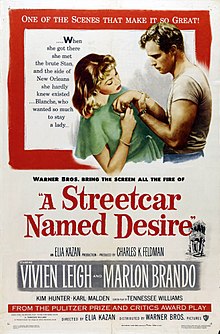
Back عربة اسمها الرغبة (فيلم) Arabic عربه اسمها الرغبه ARZ Трамвай «Жаданне» (фільм) Byelorussian Трамвай „Желание“ (филм) Bulgarian Tramvaj zvan čežnja (1951) BS A Streetcar Named Desire (pel·lícula de 1951) Catalan Tramvaj do stanice Touha (film, 1951) Czech A Streetcar Named Desire (ffilm 1951) Welsh Omstigning til Paradis Danish Endstation Sehnsucht (1951) German
| A Streetcar Named Desire | |
|---|---|
 Theatrical release poster by Bill Gold | |
| Directed by | Elia Kazan |
| Screenplay by |
|
| Based on | A Streetcar Named Desire 1947 play by Tennessee Williams |
| Produced by | Charles K. Feldman |
| Starring | |
| Cinematography | Harry Stradling |
| Edited by | David Weisbart |
| Music by | Alex North |
| Distributed by | Warner Bros. Pictures |
Release date |
|
Running time | 125 minutes[2] |
| Country | United States |
| Language | English |
| Budget | $1.8 million[3] |
| Box office | $8 million (North America)[3] |
A Streetcar Named Desire is a 1951 American Southern Gothic drama film adapted from Tennessee Williams's Pulitzer Prize-winning play of the same name. It is directed by Elia Kazan, and stars Vivien Leigh, Marlon Brando, Kim Hunter, and Karl Malden. The film tells the story of a Mississippi Southern belle, Blanche DuBois (Leigh), who, after encountering a series of personal losses, seeks refuge with her sister (Hunter) and brother-in-law (Brando) in a dilapidated New Orleans apartment building. The original Broadway production and cast was converted to film, albeit with several changes and sanitizations related to censorship.
Tennessee Williams collaborated with Oscar Saul and Elia Kazan on the screenplay. Kazan, who directed the Broadway stage production, also directed the black-and-white film. Brando, Hunter, and Malden all reprised their original Broadway roles. Although Jessica Tandy originated the role of Blanche DuBois on Broadway, Vivien Leigh, who had appeared in the London theatre production, was cast in the film adaptation for her star power.[4] The film brought Brando, previously virtually unknown, to prominence as a major Hollywood film star, and earned him the first of four consecutive Academy Award nominations for Best Actor; Leigh won her second Academy Award for Best Actress for her portrayal of Blanche. It received Oscar nominations in ten other categories (including Best Picture, Best Director, and Best Adapted Screenplay), and won Best Supporting Actor (Malden), Best Supporting Actress (Hunter), and Best Art Direction (Richard Day, George James Hopkins), making it the first film to win in three of the acting categories.
The film earned an estimated $4,250,000 at the US and Canadian box office in 1951, making it the fifth biggest hit of the year.[5] In 1999, A Streetcar Named Desire was selected for preservation in the United States National Film Registry by the Library of Congress as being "culturally, historically, or aesthetically significant".
- ^ A Streetcar Named Desire at the AFI Catalog of Feature Films. Retrieved Sept. 19, 2021
- ^ "A Streetcar Named Desire". American Film Institute. Retrieved July 4, 2017.
- ^ a b "A Streetcar Named Desire (1951)—Financial Information". The Numbers. Retrieved May 9, 2019.
- ^ Manvell, Roger. Theatre and Film: A Comparative Study of the Two Forms of Dramatic Art, and of the Problems of Adaptation of Stage Plays into Films. Cranbury, New Jersey: Associated University Presses Inc, 1979. 133
- ^ 'The Top Box Office Hits of 1951', Variety, January 2, 1952